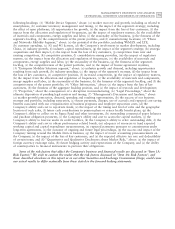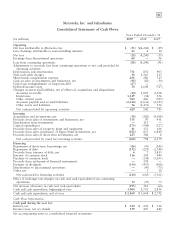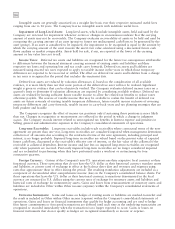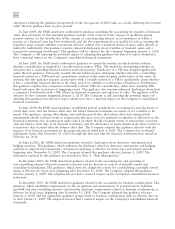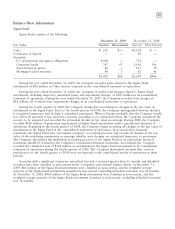Motorola 2009 Annual Report Download - page 90
Download and view the complete annual report
Please find page 90 of the 2009 Motorola annual report below. You can navigate through the pages in the report by either clicking on the pages listed below, or by using the keyword search tool below to find specific information within the annual report.
82
Motorola, Inc. and Subsidiaries
Notes to Consolidated Financial Statements
(Dollars in millions, except as noted)
1. Summary of Significant Accounting Policies
Principles of Consolidation: The consolidated financial statements include the accounts of the Company and
all controlled subsidiaries. All intercompany transactions and balances have been eliminated.
Revenue Recognition: The Company’s material revenue streams are the result of a wide range of activities,
from the delivery of stand-alone equipment to custom design and installation over a period of time to bundled
sales of equipment, software and services. The Company recognizes revenue when persuasive evidence of an
arrangement exists, delivery has occurred, the sales price is fixed or determinable, and collectibility of the sales
price is reasonably assured. In addition to these general revenue recognition criteria, the following specific revenue
recognition policies are followed:
Products and Equipment—For product and equipment sales, revenue recognition generally occurs when
products or equipment have been shipped, risk of loss has transferred to the customer, objective evidence exists
that customer acceptance provisions have been met, no significant obligations remain and allowances for
discounts, price protection, returns and customer incentives can be reliably estimated. Recorded revenues are
reduced by these allowances. The Company bases its estimates on historical experience taking into consideration
the type of products sold, the type of customer, and the type of transaction specific in each arrangement. Where
customer incentives cannot be reliably estimated, the Company recognizes revenue at the time the product sells
through the distribution channel to the end customer.
Long-Term Contracts—For long-term contracts that involve customization of the Company’s equipment or
software, the Company generally recognizes revenue using the percentage of completion method based on the
percentage of costs incurred to date compared to the total estimated costs to complete the contract. In certain
instances, when revenues or costs associated with long-term contracts cannot be reliably estimated or the contract
involves unproven technologies or other inherent hazards, revenues and costs are deferred until the project is
complete and customer acceptance is obtained. When current estimates of total contract revenue and contract
costs indicate a contract loss, the loss is recognized in the period it becomes evident.
Services—Revenue for services is generally recognized ratably over the contract term as services are
performed.
Software and Licenses—Revenue from pre-paid perpetual licenses is recognized at the inception of the
arrangement, presuming all other relevant revenue recognition criteria are met. Revenue from non-perpetual
licenses or term licenses is recognized ratably over the period that the licensee uses the license. Revenue from
software maintenance, technical support and unspecified upgrades is generally recognized over the period that
these services are delivered.
Multiple Element Arrangements—Arrangements with customers may include multiple deliverables, including
any combination of products, equipment, services and software. For multiple element arrangements including
software or software-related elements, the Company applies the applicable authoritative accounting guidance to
determine separate units of accounting and the amount of the arrangement fee to be allocated to those separate
units of accounting. Multiple element arrangements that include software are separated into more than one unit
of accounting when the following criteria are met: (i) the functionality of the delivered element(s) is not
dependent on the undelivered element(s), (ii) there is vendor-specific objective evidence of the fair value of the
undelivered element(s), and (iii) general revenue recognition criteria related to the delivered element(s) have been
met. If any of these criteria are not met, revenue is deferred until the criteria are met or the last element has been
delivered.
For all other multiple element arrangements, deliverables are separated into more than one unit of accounting
when the following criteria are met: (i) the delivered element(s) have value to the customer on a stand-alone basis,
(ii) objective and reliable evidence of fair value exists for the undelivered element(s), and (iii) delivery of the
undelivered element(s) is probable and substantially in the control of the Company. Revenue is allocated to each
unit of accounting based on the relative fair value of each accounting unit or using the residual method if



